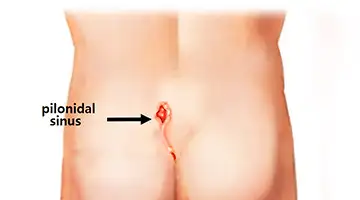Pilonidal Sinus Surgery in Delhi NCR
Advanced Pilonidal Sinus Surgery in Delhi NCR. Glamyo Health offers free doctor consultation with the best laparoscopic surgeons. We have partnered with top hospitals in Delhi NCR for pilonidal sinus surgery. It is a scarless and minimally painful procedure with a shorter recovery time.
Get in touch with us for safe and affordable Pilonidal Sinus Treatment in Delhi NCR.

1 Lakh+
Happy Patients
350+
Doctors
200+
Hospitals
40+
Cities
40,000+
Surgeries
WHY BOOK PILONIDAL SINUS SURGERY WITH GLAMYO HEALTH?
 Best Surgeons
Best Surgeons
 1 Day Discharge
1 Day Discharge
 Free Follow Ups
Free Follow Ups
 Free Pick Up & Drop Service
Free Pick Up & Drop Service
 All Insurances Covered
All Insurances Covered
 Advanced Procedure
Advanced Procedure
PILONIDAL SINUS TREATMENT IN Delhi NCR
A Pilonidal sinus is a small tunnel or hole in the skin that becomes clogged with pus, fluid, and debris, causing a cyst or abscess to form. Pilonidal sinus is formed In the cleft at the top of the buttocks. A pilonidal sinus is commonly loaded with hair and dirt in addition to fluid and debris. If not treated promptly, the condition can cause significant discomfort, and the infection is likely to spread to other parts of the body.
When a pilonidal sinus becomes infected, it may exude pus and infected blood, as well as generate a bad odour. A pilonidal sinus is commonly loaded with hair and dirt in addition to fluid and debris. If not treated promptly, the condition can cause significant discomfort, and the infection is likely to spread to other parts of the body. When a pilonidal sinus becomes infected, it may exude pus and infected blood, as well as generate a bad odor.
Pilonidal Sinus requires immediate Treatment & Surgeries, You can get in touch with Glamyo Health and get the Best Pilonidal Sinus Surgery in Delhi NCR, by The Best Pilonidal Sinus Specialists in Delhi in the Best Pilonidal Sinus clinic nearby.

PILONIDAL SINUS DOCTORS IN Delhi NCR
View AllPILONIDAL SINUS HOSPITALS & CLINICS IN Delhi NCR
View All
Ruby Hall Clinic
Pune
MON-SAT | 10:00 am - 11:00 pm
Top Treatments
General Specialist,Gallstone,F...
PILONIDAL SINUS SURGERY COST IN Delhi NCR
View All
Type of surgery : Pilonidal Sinus
Hospitalization time : 1-2 Days
Cost range : 60,000 INR to 90,000 INR
For the Cost Estimate : CALL NOW
For the Cost Estimate : CALL NOW
PILONIDAL SINUS TREATMENT REVIEWS IN Delhi NCR
View All
Arun mane
Pilonidal s ...
Hi, my name is Arun Mane. I got to know about Glamyo Healtj through the internet. I appreciate their work and the efforts that t read more

 Pilonidal sinus | Surgeries
Pilonidal sinus | Surgeries Dr. Niraj B. Singh4
Dr. Niraj B. Singh4  Mallika Hospital And...
Mallika Hospital And...  Mumbai
Mumbai

Sudipto Sar ...
Pilonidal s ...
Hi, my name is Sudipto Sarkar and recently I had a safe surgery in a nearby well-known hospital. I had a sinus for a long time n read more


Tribhuwan S ...
Pilonidal s ...
Thanks Glamyo Health. Your service was very nice. I'll give 100 out of 100. I got the best service from Glamyo Health for pil read more

 Pilonidal sinus | Surgeries
Pilonidal sinus | Surgeries Dr. Shuddhatam jain4
Dr. Shuddhatam jain4  VC Clinic
VC Clinic  New Delhi
New Delhi

Soumen Karm ...
Pilonidal s ...
My name is Soumen Karmakar. I read about Glamyo Health on Facebook and I opened the given link to fill out the general form. Nex read more

 Pilonidal sinus | Surgeries
Pilonidal sinus | Surgeries Dr. Sunny Agarwal5
Dr. Sunny Agarwal5  Kripa Hospital Mumba...4.5 (11)
Kripa Hospital Mumba...4.5 (11) Mumbai
Mumbai

Manjeet sin ...
Pilonidal s ...
I'm very happy and satisfied with Glamyo Health..and my medical coordinator Mr. Nikhil Sharma was very polite ,humble and helpfu read more

 Pilonidal sinus | Surgeries
Pilonidal sinus | Surgeries Dr. V Devendran5
Dr. V Devendran5  Lexinia Laser Clinic4.6 (1458)
Lexinia Laser Clinic4.6 (1458) Bangalore
Bangalore

Mohhamad ai ...
Pilonidal s ...
I was facing Pilonidal Sinus problem since few years, then i surfed google for the solution and there I found Glamyo Healthcare. read more

 Pilonidal sinus | Surgeries
Pilonidal sinus | Surgeries Dr. Kapil Aggarwal4
Dr. Kapil Aggarwal4  Irene Hospital4.4 (125)
Irene Hospital4.4 (125) New Delhi
New Delhi
BENEFITS OF LASER TREATMENT
- Pain
- Stitches
- Recovery
- Blood Loss
- Follow Ups
- Cuts & Wounds
LASER SURGERY
- Minimally Painful
- Nominal
- 2 - 3 Days
- No or Minimal Blood Loss
- Not Required
- No
OPEN SURGERY
- Extremely Painful
- Significant
- 2 - 3 Weeks
- Significant Blood Loss
- Required
- Yes
WORRIED ABOUT PRICE?
Glamyo has made the latest, laser treatment for Pilonidal Sinus affordable and accessible to all.
- Interest-Free EMI Facility
- Free Follow-up Consultation
- Free Pickup & Drop For Surgery
PILONIDAL SINUS SURGERY IN Delhi NCR
Pilonidal Sinus is a very prevalent anorectal disease. It is an abnormal pocket in the skin containing Dirt & Debris. However, the majority of people are unaware of the problem. Even if they are aware of the situation, discussing or consulting about anorectal issues with another person or a Doctor is not always comfortable. Pilonidal Sinus, like any other health issue, has the potential to cause complications in a person's daily life and even in the Long run.
If not addressed promptly, these issues can worsen. This article by Glamyo Health aims to educate readers about the Best Pilonidal Sinus treatment options, Best Pilonidal Sinus Surgery in Delhi NCR to opt for alongside the Best Pilonidal Sinus Doctors in the Best Hospital for Pilonidal Sinus.
Surgical and non-surgical options for Pilonidal Surgery in Delhi NCR
Lancing: Lancing is a procedure that is performed under the influence of a local anaesthetic. The surgery relieves the abscess's unpleasant symptoms. The proctologist sedates the patient with an anaesthetic before starting the therapy. The doctor next opens the abscess with a knife and cleans out the filth, blood, hair, and debris.
After cleansing, the doctor will apply a sterile dressing to the area and allow it to heal from the inside out. It could take anything from 4-6 weeks for the body to recuperate. This treatment is frequently effective, and the patient usually does not require further treatment.
Open Surgery: There are two methods of open surgery for the pilonidal Sinus: incision and drainage and pilonidal cystectomy.
Incision & Drainage: When a cyst becomes infected, an open treatment called incision and drainage is used. It is done under local anaesthetic to numb the afflicted area. To remove the infectious fluid and pus from the cyst, the surgeon creates an incision.
In addition, the doctor covers the hole with gauze and allows it to heal on its own. The cyst can take up to 4-6 weeks to completely heal. The gauze should also be changed on a regular basis.
Pilonidal cystectomy: Pilonidal cystectomy is the surgical removal of the complete pilonidal cyst. For a recurring cyst, doctors used to conduct this traditional surgery. It's also done after a general or regional anaesthetic has been administered. The afflicted skin, as well as underlying hair follicles, tissues, and dead cells, are removed through a cut made by the surgeon.
The doctor may or may not pack the area with surgical gauze, depending on the size of the cyst removed. When the infection is severe, the doctor inserts a tube into the cyst to drain the fluid. When all of the fluid from the cyst has been collected, the tube is withdrawn. This reduces the likelihood of recurrence.
Laser Treatment: The surgeon utilises a high-intensity laser beam to shut off the Sinus during the procedure. In order to prevent the recurrence of the infection, the doctor ensures that the entire pit of the pilonidal Sinus is removed. In comparison to the previously described methods of open surgery, it is a simpler and more precise technique to undertake. Furthermore, because there are wounds that need to heal, only one day of dressing is required. The laser energy also speeds up the healing process at the operation site. As a result, recovering following laser surgery for the pilonidal Sinus takes only a few days.
Non-Surgical Treatment: If there are no signs of inflammation or infection, the doctor is likely to recommend a broad-spectrum antibiotic as the first line of treatment. A broad-spectrum antibiotic is effective against a large range of germs. The ointments do not repair the sinuses, but they do provide symptomatic relief from discomfort and inflammation. A follow-up test and good anal hygiene are likely to be recommended by your doctor.
If you are looking for the best, most advanced, effective & affordable pilonidal sinus treatment, we would suggest you opt for a Laser Pilonidal Sinus Surgery in Delhi NCR, as laser surgery has a lot of advantages and a quicker recovery rate, and very low chances of recurrence.
FREQUENTLY ASKED QUESTIONS
YOUR JOURNEY WITH US
Free Doctor Consultattion

Smooth Hospital Admission

Hassle Free Insurance Approval

Advanced Day Care Surgery

Free Pick Up & Drop Services












 New Delhi
New Delhi  Bangalore
Bangalore  Mumbai
Mumbai  Hyderabad
Hyderabad  Pune
Pune  Chennai
Chennai 
